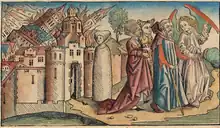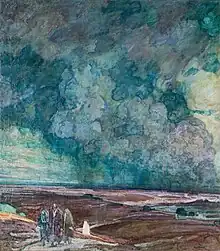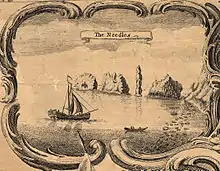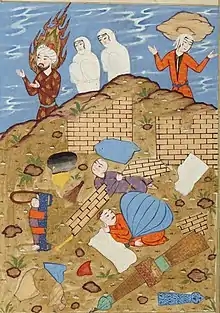Lot's wife
In the Bible, Lot's wife is a figure first mentioned in Genesis 19. The Book of Genesis describes how she became a pillar of salt after she looked back at Sodom. She is not named in the Bible but is called "Ado" or "Edith" in some Jewish traditions. She is also referred to in the deuterocanonical books at the Book of Wisdom (Wisdom 10:7) and the New Testament at Luke 17:32.
| Lot's wife | |
|---|---|
 For disobeying God by watching Sodom's destruction, Lot’s wife is turned into a "pillar of salt" while Lot and their daughters escape (Monreale Cathedral mosaic) | |
| In-universe information | |
| Alias | Ado |
| Spouse | Lot |
| Children | 2 daughters |
| Relatives | Haran (father-in-law) Milcah (sister-in-law) Iscah (sister-in-law) Nahor (uncle-in-law) Abraham (uncle-in-law) Sarah (aunt-in-law) |
| Birth place | Ur Kaśdim |
| Death place | Sodom |
Genesis narrative
The story of Lot's wife begins in Genesis 19 after two angels arrived in Sodom at eventide and were invited to spend the night at Lot's home. The men of Sodom were exceedingly wicked and prompted Lot to offer up these men/angels to have sex with; instead, Lot offered up his two daughters but they were refused. As dawn was breaking, Lot's visiting angels urged him to get his family and flee, so as to avoid being caught in the impending disaster for the iniquity of the city. The command was given, "Flee for your life! Do not look behind you, nor stop anywhere in the Plain; flee to the hills, lest you be swept away."[1]: 465 While fleeing, Lot's wife looked behind her at Sodom and was turned into a pillar of salt.[1]: 466
Composition
The Hebrew verb used for Lot's wife "looking" back is תבט (tāḇeṭ). Her looking back at Sodom differs in word usage from Abraham "looking" (שקף šāqap) toward Sodom in 18:16.[2]: 49
Pillar of salt

The story appears to be based in part on a folk legend explaining a geographic feature.[3]
A pillar of salt named "Lot's wife" is located near the Dead Sea at Mount Sodom in Israel.[4] The Mishnah states that a blessing should be said at the place where the pillar of salt is.[1]: 467 [5] The term "Lot's wife" for such geographical features subsequently entered common parlance, as one of the outcrops comprising Long Ya Men was also nicknamed thus.[6]
The Jewish historian Josephus claimed to have seen the pillar of salt which was Lot's wife.[7] Its existence is also attested to by the early church fathers Clement of Rome and Irenaeus.[8]
Jewish commentaries
In Judaism, one common view of Lot's wife turning to salt was as punishment for disobeying the angels' warning. By looking back at the "evil cities," she betrayed her secret longing for that way of life. She was deemed unworthy to be saved and thus was turned to a pillar of salt.[9]
Another view in the Jewish exegesis of Genesis 19:26, is that when Lot's wife looked back, she turned to a pillar of salt upon the "sight of God" descending to rain destruction upon Sodom and Gomorrah.[1]: 467 One reason given in the tradition is that she looked behind her to see if her daughters, married to men of Sodom, were coming or not.[1]: 467
Another Jewish legend says that because Lot's wife sinned with salt, she was punished with salt. On the night the two angels visited Lot, he requested that his wife prepare a feast for them. Not having any salt, Lot's wife asked her neighbors for some, which alerted them to the presence of their guests, resulting in the mob action that endangered Lot's family.[1]: 467
In the Midrash, Lot's wife's name is given as Ado[10] or Edith.[11]
Islamic view
Lut (Arabic: لوط, romanized: Lūṭ) in the Quran is considered to be the same as Lot in the Hebrew Bible. He is considered to be a messenger of God and a prophet of God.[12]
In the Quranic telling, Lut warned his people of their imminent destruction lest they change their wicked ways, but they refused to listen to him. Lut was ordered by Allah to flee the city with his followers at night, but to leave his wife behind. As soon as he left, Allah brought down upon them a shower of stones of clay.[13]
The difference between this telling and the Judeo-Christian telling from the Book of Genesis is that Lut's wife was destroyed alongside the wicked; in other words, she did not flee with Lut. This is because Lut's wife was as guilty as those who were punished. So much so, that she is mentioned in the Quran alongside Nuh's wife as two impious and disbelieving women who were punished for their wickedness, irrespective of their being married to prophets.[14]
In the Quran, surah (chapter) 26 Ash-Shu'ara (The Poets) –
So We saved him and his family, all, Except an old woman among those who remained behind.
— Quran 26:170-171
Commentary: This was his wife, who was a bad old woman. She stayed behind and was destroyed with whoever else was left. This is similar to what Allah says about them in Surat Al-A`raf and Surah Hud, and in Surat Al-Hijr, where Allah commanded him to take his family at night, except for his wife, and not to turn around when they heard the Sayhah as it came upon his people. So they patiently obeyed the command of Allah and persevered, and Allah sent upon the people a punishment which struck them all, and rained upon them stones of baked clay, piled up.
Other biblical references
Lot's wife is mentioned by Jesus at Luke 17:32[15] in the context of warning his disciples about difficult times in the future when the Son of Man would return; he told them to remember Lot's wife as a warning to not waver at that time.[16] Lot's wife is also referred to in the apocrypha in Wisdom 10:7 - "a pillar of salt standing as a monument to an unbelieving soul."
Popular culture

The poem, "Lot's Wife" by Anna Akhmatova, offers a more compassionate approach to Lot's wife's decision to look behind her. Scott Cairns' poem, "The Turning of Lot's Wife", also reimagines the story from a feminist perspective. In the first chapter of Slaughterhouse-Five by Kurt Vonnegut, the author praises Lot’s wife for looking back knowing it would destroy her. Vonnegut compares her looking at Sodom to his recalling the fire bombing of Dresden.[17]
The story of Lot's wife is paralleled in Shirley Jackson's short story "Pillar of Salt", in which a woman visiting New York with her husband becomes obsessed with the crumbling of the city.
The musical Caroline, or Change features a climactic aria titled "Lot's Wife," which Tonya Pinkins performed at the 58th Tony Awards to represent the original Broadway production's Best Musical nomination. The song alludes to the story of Lot's wife as a release from the evil and heartache of life.
Gallery
 A rock formation near the Sanctuary of Agios Lot venerated as Lot's wife as a pillar of salt
A rock formation near the Sanctuary of Agios Lot venerated as Lot's wife as a pillar of salt "Lot's Wife" pillar of salt, Mount Sodom, Israel.
"Lot's Wife" pillar of salt, Mount Sodom, Israel. The 'Lot's wife' sea-stack, Marsden Bay, South Shields, North East England, United Kingdom located on the North Sea coast
The 'Lot's wife' sea-stack, Marsden Bay, South Shields, North East England, United Kingdom located on the North Sea coast The conspicuous conical white painted beacon at Baltimore, Ireland is locally nicknamed The Pillar of Salt or Lot's wife
The conspicuous conical white painted beacon at Baltimore, Ireland is locally nicknamed The Pillar of Salt or Lot's wife

See also
References
- Schwartz, Howard (2004). Tree of Souls: The Mythology of Judaism. Oxford University Press. ISBN 9780195358704.
- Hamilton, Victor P. (1995). "looking (back)". The Book of Genesis: Chapters 18-50 (Google eBook) (2nd. ed.). Grand Rapids Michigan: Eerdmans. p. 49. ISBN 9780802823090.
- Hirsch, Emil G.; Seligsohn, M.; Schechter, Solomon; Jacobs, Joseph (1906). "Lot". Jewish Encyclopedia.
- Lefond, Stanley J. (2012). Handbook of World Salt Resources. Springer. p. 337. ISBN 9781468407037.
- (Talmud B. Ber. 54a)
- National Library Board (2014). Wang Dayuan - Singapore History.
- Josephus. Antiquities of the Jews. Book I. Chapter 11. Verse 4.
- Josephus. Antiquities of the Jews. Book I. Endnote Number 23
- Scharfstein, Sol (2008). Torah and commentary : the five books of Moses : translation, rabbinic and contemporary commentary. Jersey City, NJ: KTAV Publishing. p. 71, #26. ISBN 9781602800205.
- Book of Jasher 19:52. Internet Sacred Text Archive.
- Friedlander, Gerald, ed. (1916). Pirkê de Rabbi Eliezer. London: Paul, Trench, Trubner & Co. p. 186.
- Quran 26:161
- Quran 51:33-34
- Quran 66:10
- "Lot". Catholic Encyclopedia.
- Carroll, John T. (2012). Luke a commentary (1st ed.). Louisville, Kentucky: Westminster John Knox Press. p. 351. ISBN 9781611642025.
- Minx, Bjorn (2008). "Literature and Ethics: Social Critique and Morality in the American War II Novel". Ethics in Culture. Walter de Gruyter. p. 350. ISBN 978-3-11-020072-0.
- "One Inch Maps". University of Portsmouth.
- "Geography Department website". University of Portsmouth. Archived from the original on 26 October 2007.
- "Taylor's Hampshire 1759, Martin and Jean Norgate". University of Portsmouth.
- "Geography Department website". 2004. Archived from the original on 26 October 2007.
External links
![]() Media related to Lot's wife made into a pillar of salt at Wikimedia Commons
Media related to Lot's wife made into a pillar of salt at Wikimedia Commons
